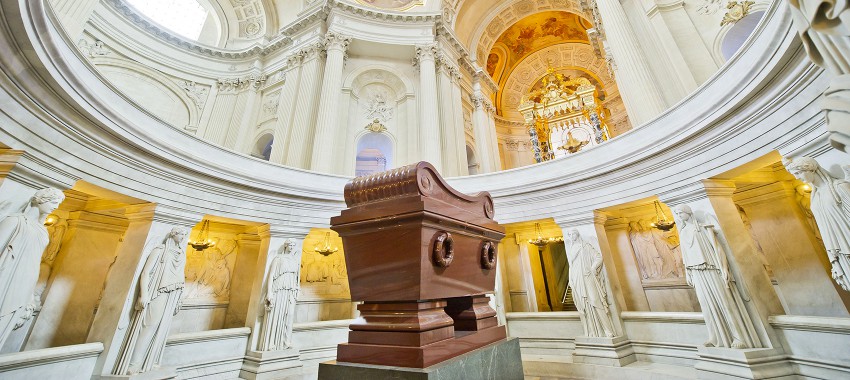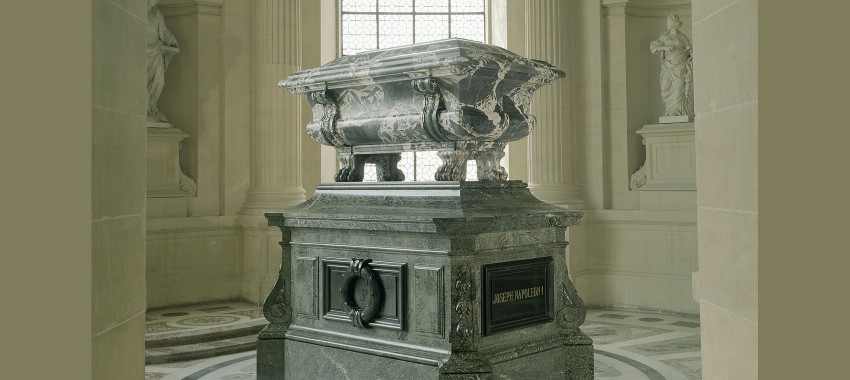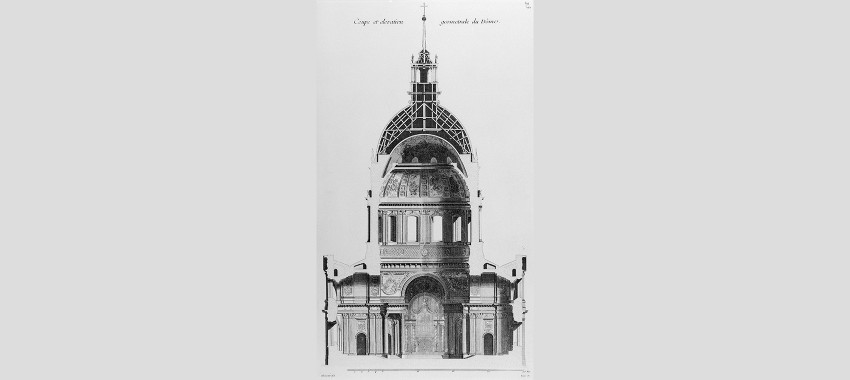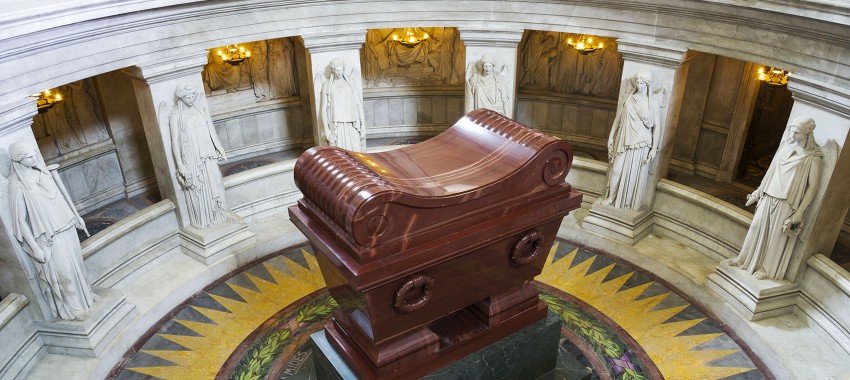Restoring the Tomb of Napoleon I and the Napoleonic monuments at Les Invalides
RESTORING THE TOMB OF NAPOLEON I
AND THE NAPOLEONIC MONUMENTS
AT THE HÔTEL NATIONAL DES INVALIDES
THIS APPEAL IS NOW CLOSED.
For the bicentenary of Napoleon I’s death on 5 May 2021, the Musée de l’Armée and the Fondation Napoléon are joining forces to launch an international appeal to help restore, at the Hôtel National des Invalides, the monuments associated with the Emperor and his brothers Joseph, King of Naples and later of Spain, and Jerome, King of Westphalia and later Governor of Les Invalides.
The restoration and refurbishment of these monuments will presented to the public as part of a larger “Napoleon Season” – a major exhibition, concerts, talks and many other events – proposed by the Musée de l’Armée, as part of the “2021 Année Napoléon” [Napoleon Year].
The objective of this fundraiser was to raise 800,000 euros.
2,310 donors contributed to this appeal, thanks to whose generosity 836,960 euros were raised.
The Fondation Napoléon and the Musée de l’Armée would like to thank each and every one of them.
► Read the final report (1st February 2021; pdf, in French)
► Read the list of donors (1st March 2021; pdf, in French)
The Restoration of the Emperor’s Tomb
Completed in 1862, the majestic tomb of red quartzite receives ongoing maintenance by the Musée de l’Armée. Even though its general condition is satisfactory, time has taken its toll and here is what’s needed:
- The restoration of the floor: several parts of the stone, enamel and marble inlay were damaged some years ago by pieces of masonry falling from the dome above, which itself has since been repaired.
- Renewing the gilding of the inscription, over the entrance to the crypt, of the Emperor’s last wishes: “Je désire que mes Cendres reposent sur les bords de la Seine, au milieu de ce peuple français que j’ai tant aimé” (“I wish that my mortal remains may repose on the banks of the Seine, surrounded by the French people that I loved so much”).
- The meticulous cleaning of the tombstones of Generals Duroc and Bertrand, of the funeral genies which “guard” the entrance to the crypt, and more generally, of all the statues and other decorative elements.
- The consolidation of all the floors around the tomb itself: the circular marble and enamelled floor.
The Restoration of the other Napoleonic Monuments
- King Joseph’s Tomb: this tomb (completed in 1862) and currently open to the public, needs a thorough cleaning.
- King Jerome’s Tomb: this tomb (which dates from 1860), has been inaccessible to the public for several years and needs the same attention as that of his brother Joseph. The tomb of Jerome Bonaparte is located in the “Chapelle Saint-Jérôme”, which is where the Emperor’s mortal remains were laid to rest when they were first brought back to France in 1840. After restoration work, the chapel will be opened once again to the public.
- The Chapelle Napoléon, located in the Église des Soldats (Soldiers’ Church), served as the second “chapelle ardente” (chapel of rest) for Napoleon’s mortal remains while the Dome Church was undergoing the most important construction work. The chapel has only rarely been open to the public, and its decor is virtually unchanged since that time. There are also several paintings depicting the “Retour des Cendres” (Return of Napoleon’s mortal remains), which, along with the rest of the furniture, will be included in the chapel’s restoration.
- The tombslabs from St Helena in “le Jardin de l’Intendant”: When the French expedition (known as the “Retour des Cendres”), undertaken by the Comte de Rohan-Chabaud and the Prince de Joinville, brought back the Emperor’s mortal remains from St Helena in 1840, they also brought with them the heavy stones which had covered the Tomb on St Helena, the first burial site of the Emperor.
There are four of these stone slabs: one had been buried underground, resting directly above the coffins (which were themselves placed one inside each other); the other three slabs, at ground level, were visible to all those who came to visit the tomb. For many years they were displayed in the “Chapelle Napoléon” part of the Eglise des Soldats, but in the 1970s, these stone slabs were transferred to the “Jardin de l’Intendant”, a small garden adjacent to the cathedral. The plan is to clean and protect the stones, and also to improve their appearance with a new landscape design, lighting, as well as installing new media tools, all of which will facilitate public visits, weather-permitting. [Given difficulties specific to this part of the restoration project, it is possible that this tranche will be realised at a later date, in a second stage.]
Take a look at some photos of items in need of restoration.
Why donate?
By helping to restore the Emperor’s last resting place and the other monuments which surround it, you can play a key role in the preservation of a great monument symbolic of France’s historic and artistic heritage.
After successfully piloting a number of recent appeals (The French Domains of St Helena; the restoration of the Chasseur Colonel’s uniform worn by the Emperor on St Helena which today belongs to the Museums of Sens, as well as the restoration of the drawings and plans made for the Emperor and conserved at the French National Archives), the Fondation Napoléon is in charge of raising the funds so that the Musée de l’Armée can carry out and finish the planned restorations at Les Invalides.
Supporting this appeal also gives rise to tax benefits for taxpayers in France and in certains states in the US.
Since the Fondation Napoléon is a registered charity (“reconnue d’utilité publique par décret du 12 novembre 1987)”, donations made to it – either by private individuals or by companies fiscally resident in France – are therefore tax-deductible:
- For individuals who pay tax in France, donations known as ‘manual donations’, meaning direct payments to the Fondation Napoléon in cash, cheque or by bank transfer, result in an income tax reduction of 66% of the amount of the donation, with donations limited to 20% of the donor’s taxable annual revenue.
Example: for a donation of €1,000, the donor can deduct €660 from their income tax. - Donations may result in a reduction of property tax (IFI), with the limit being 75% of a capped donation sum of €50,000 (this cap is reached when the real donation is €66,666; example: a donation of €1,000 leads to a tax saving of €750).
- Companies registered fiscally in France, can benefit from an income tax reduction equivalent to 60% of the donation amount, with a limit of €5 per €1000 of pre-tax turnover.
If you live in the United States, your donation towards the restoration of the Napoleonic monuments at Les Invalides may qualify for tax rebate depending on which state you live in*. To donate to the appeal, please go to the website of the Friends of the Fondation de France, and specify “Fondation Napoléon” as the benificee.
*Tax relief is available the following states: California, the District of Columbia, Florida, Illinois, Maryland, Massachusetts, New Jersey, New York, Pennsylvania, Virginia, and Washington.
If you make a donation over 20 euros you will also receive a donor’s certificate attesting to your donation.
If you donate more than 100 euros you will be invited to a special tour of the exhibition which will be presented at the Musée de l’Armée as a part of the Napoleon Season in 2021. Furthermore, you will be given special opportunities to attend other events of this cultural programme.
If you donate an amount equal to, or more than 1,500 euros, you will, in addition to these other privileges, receive a medal specially minted on the occasion of this subscription.
Read the operation’s leaflet (28 January 2020; pdf)
If you have any other questions don’t hesitate to contact us
published 3 May 2019, updated 3 February 2021.












